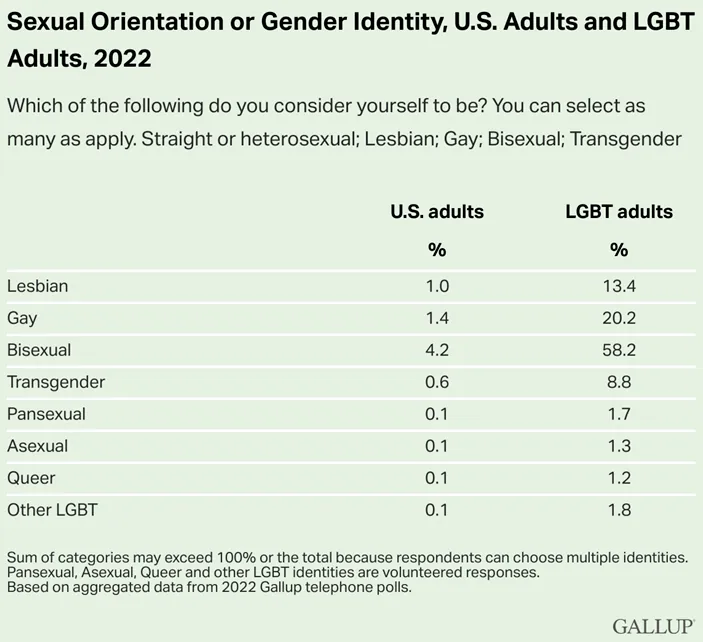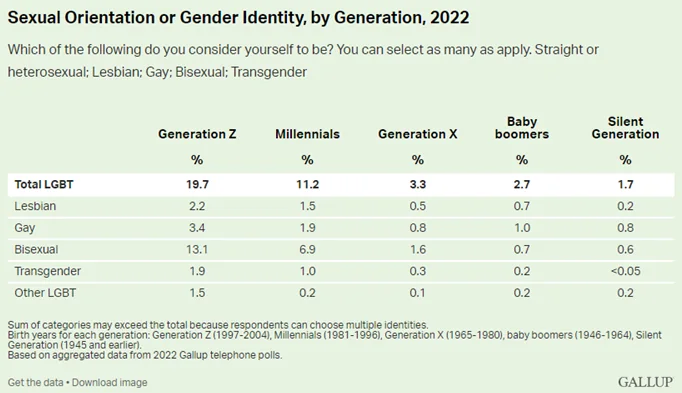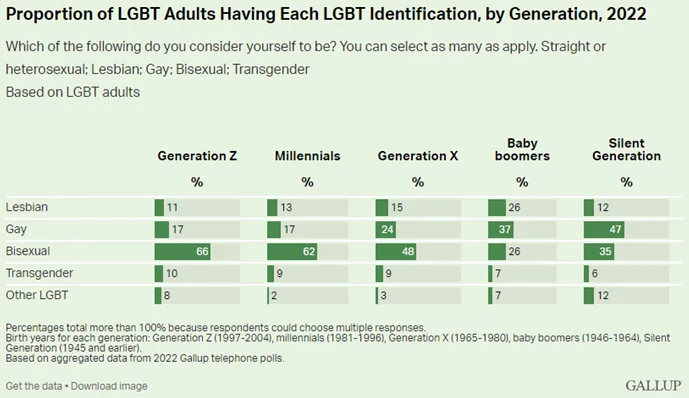
Diversity triumphs: the LGBTQ+ community in the United States remains strong in 2022!
We’re thrilled to share some incredible news: according to a recent Gallup survey, the percentage of American adults identifying as LGBT+ has remained steady at 7.2% in 2022 - almost double what it was ten years ago.
This positive development is a testament to the growing acceptance and recognition of non-heterosexual sexual orientations and gender identities in our society. It’s heartening to see that this trend continues year after year, showing an increase in the stability of current attitudes.
As we celebrate this milestone, let us remember that there’s still much work to be done toward achieving true equality and justice for all members of our community. But for now, let’s take a closer look at the numbers and understand their implications.
A recent Gallup telephone survey conducted in 2022 found that the number of people identifying as lesbian, gay, bisexual, transgender, or other than heterosexual has more than doubled compared to a similar survey conducted in 2012. The report reveals that 7.2% of respondents chose to identify as LGBTQ+. However, note that the majority of American adults (86%) still consider themselves heterosexual, and only a small percentage (7%) chose not to answer the question.

Among U.S. adults:
Interestingly, 5% of respondents indicated an identity other than lesbian, gay, bisexual, or transgender. And most of them - 1-2% - identified themselves as queer, pansexual, or asexual.

Recent statistics on LGBTQ+ identification reveal some interesting generational differences.
The younger generation - Generation Z (aged 18 to 25 in 2022) - is leading the way with a staggering rate of 19.7% of them identifying as LGBTQ+, followed by Millennials at a rate of 11.2%, while Generation X lags with only a rate of 3.3%.

Also, bisexuality is the most common form of LGBTQ+ identity among young adults. Approximately 66% of Generation Z and 62% of Millennials identify as bisexual.
Additionally, within the LGBTQ+ community, the largest subgroup among Generation X (adults born between 1965-1980) are those who identify as bisexual, making up 48% of the group.
Moreover, the Baby Boomers (born between 1946-1964) and the Silent Generation (born in 1945 and earlier) have a higher representation of individuals who identify as gay within the LGBTQ+ community.
The United States has experienced a significant societal shift over the past decade, with more people identifying as LGBTQ+. While this trend has stabilized in recent years, the younger generation is more likely to identify as part of the LGBTQ+ community than their older counterparts. This suggests that we may continue to see growth in the future.
Statistics on LGBTQ+ identification reveal progress toward acceptance and inclusion. However, there is still much work to be done to achieve true equality and justice for all members of our community.
So, society needs to acknowledge and protect the rights of LGBTQ+ individuals and embrace diversity across all generations. Therefore, let’s continue advocating for equal rights for all individuals and promoting diversity and inclusion. This will help build a better future where everyone can be themselves without fear of discrimination or prejudice.
As we strive for enhanced inclusivity, it’s critical to acknowledge and embrace each individual’s unique experiences. By working together, we can build a society that places diversity at the heart of its values. By doing so, we can ensure a brighter and more equitable future for all.
Comments